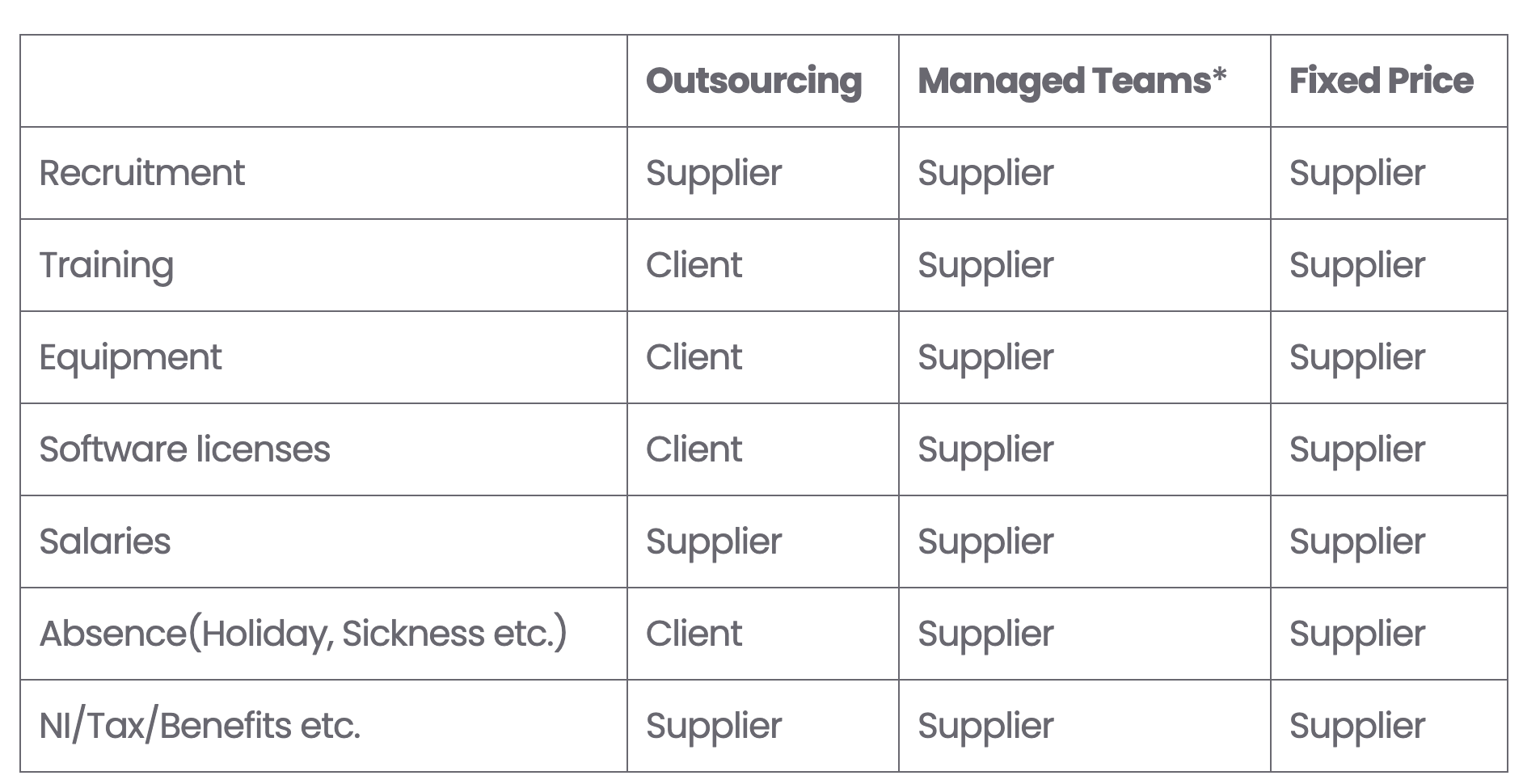
Team extension, managed services and fixed price projects. For whom, how much, when and why?
In outsourcing managed teams, cost and conditions vary by contract type- team extension, managed services, and fixed price, each with specific responsibilities, costs, and project suitability.
Outsourcing managed teams. Costs and conditions
Nothing generates as much debate and apprehension as price negotiation. Development begins with the choice of software development contracting and pricing model that the supplier provides. So, let’s take a closer look at 3 types of contracts in the software outsourcing world.
Team extension
Personnel outsourcing, or ‘team extension’, is used when your organisation needs to acquire an employee or a team of employees with specific IT skills for a limited time or a specific project.
Candidates with suitable profiles can provide a fresh view of the project, system or workflow. It is priceless since it often happens that, because your employees know the company’s processes very well, they cannot suggest innovative changes. Of course, it is worth remembering that you will need someone in your company who can assess the work of the external consultants.
Usually, the price for such a specialist, or team of specialists, comprises the monthly salary of all hired employees plus additional costs for administrative needs. What are the advantages of such a solution? Control, professionalism, predictability and reduction of costs. It is you who manages the team or specialist and determines the workload. However, you don’t spend much time finding and recruiting experts. But it is you who lists the requirements. Administration of the team is managed by the provider. And last but not least, you always know the next month’s payments and taxes.
It is an excellent solution for long-term or large in-house projects when you do not have enough staff, or your staff lacks some skills.
Managed services
Similar benefits come from managed services. In this case, however, the supplier will provide comprehensive support for the new process and have more opportunities to get to know your business in more depth. In this model, full responsibility for part of the IT area in your company, or perhaps the entire area, is transferred to the external company, supporting the construction of the most effective IT strategy and conducting IT projects. It can involve not only the use of the resources and knowledge of the experienced technology partner but also responsibilities related to the administration of hardware and software resources of your company. You benefit from the specialist knowledge and experience of engineers and IT architects, without restriction, based on the best technological solutions on the market.
Fixed price projects
This IT outsourcing model works best for projects with a predefined scope of tasks, rigid requirements and predictable time frames. This model requires you to provide a detailed list of project requirements and all the necessary developer documentation so the contractors can design a scope of work and work according to a strict roadmap with unchangeable deadlines. Put simply, this model works best on short-term projects (1-4 months) with well-formed specifications and time frames. Usually, the budget is not big here, so it becomes critical to keep within its scope. Our advice is to choose a reliable outsourcing partner to make it work properly. The undoubted advantages of this approach are clarity and precision. Everybody knows what to do, when and how. The project scope and time frames are known in advance, so the team can easily set the deadlines and monitor the project’s progress.
Which is best?
Will outsourcing provide your company with cost savings? Proponents of this solution suggest minimising part of the costs associated with the worker’s employment process, training and leave. It’s hard to deny. The fixed price model is great for short‐term projects when you need quick results on a tight budget. However, this is not a suitable long‐term strategy, and you will still not save as much as you could by deciding on comprehensive managed services. In this case, you save not only on personnel costs but also in connection with the operation and management of IT infrastructure.
Who takes responsibility for delivery?
When a project is outsourced, the client takes responsibility for delivering every part of the project. This includes project planning, analysis, documentation, UI/UX design, development, testing and project management. On the other hand, the supplier takes complete responsibility for delivering a fixed-price project. Lastly, in a managed teams project, the client manages the project planning, while the supplier manages the development of the project delivery. For all other aspects of delivery within a managed team project, the client or the supplier takes responsibility. This is decided between them.

*Depends on the size and make-up of the teams
Who takes responsibility for costs?
When a project uses a fixed price or managed teams model, the supplier takes responsibility for all costs. This includes the cost of recruitment, training, equipment, software licenses, salaries, absence and national insurance/tax/benefits. In contrast, the supplier only takes responsibility for the cost of recruitment, salaries and national insurance/tax/benefits within an outsourced project. The client deals with all other costs.

Advantages and disadvantages
There is a range of benefits and drawbacks associated with each model of project delivery.
An outsourced project can suit any size of the project, and the delivery of the project can be continuous. The specific requirements and development of the project can be flexible, and the client is usually heavily involved in project development and delivery.
A managed team project suits large and mid-size projects and regular deliveries. This model suits high-level or evolving project requirements, and the development can be flexible. Again, the client is significantly involved in the project.
A fixed-price project suits a small-scale project and a one-off delivery style. The supplier deals with the project requirements, and the project development needs to be fixed instead of flexible. There is some client involvement in developing and delivering the project, but this involvement is not substantial.

Contact us.
If you need a partner in software development, we're here to help you.
We will respond to your enquiry immediately.